|
Dressing Up the Glass
Vase
by Bob Brooke
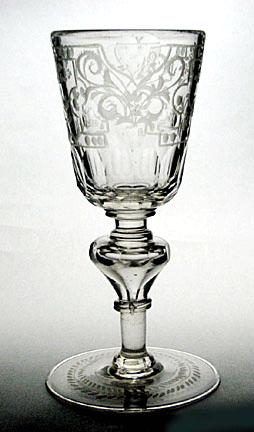 When
anyone mentions Bohemian art glass, many people immediately imagine the
delicate forms of art glass prevalent in the latter half of the 19th
century. But glassmaking in Bohemia goes back much further to the 16th
century. When
anyone mentions Bohemian art glass, many people immediately imagine the
delicate forms of art glass prevalent in the latter half of the 19th
century. But glassmaking in Bohemia goes back much further to the 16th
century.
The Napoleonic Wars brought disaster to the glasshouses of Bohemia. For
nearly 20 years, the markets in Spain and the Americas had been closed
and trade with Britain, the Low Countries and Holland disrupted. But the
18th-century supremacy of Bohemian cut and engraved glass had been
threatened even before the French Revolution, as the fashion for English
and Irish lead glass—simple, facet-cut, lustrous and relatively cheap –
became popular throughout Europe.
By the time Napoleon had been exiled to St. Helena in 1815, the
glasshouses faced an uncertain future. The British had undercut their
traditional markets and the decorative colored and opaque glass of
Clichy, St. Louis and Voneche (later Baccarat) had established the
fashionable French Empire style.
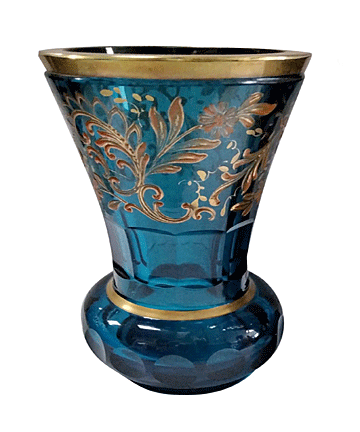 Bohemian
glassworkers in the 19th century developed an entirely new style and
composition of glass and recaptured their former supremacy. Bohemian
glassworkers in the 19th century developed an entirely new style and
composition of glass and recaptured their former supremacy.
By the 1860s, the Industrial Revolution had created new wealth and
brought railroads to Bohemia. A growing middle class demanded luxury in
the decorative arts, including glass. While aristocrats still purchased
ornate chandeliers and tableware, they increasingly desired decorativve
glass objects for display and use.
Considering their enormous production in the 19th century, Bohemian
glasshouses remained behind in adopting modern technology. As late as
1870, a dozen of the 169 large furnaces burned coal. Families strictly
controlled by the families who owned them.
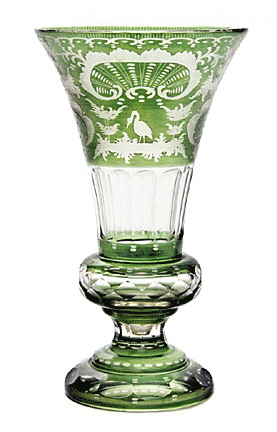 Glassblowers
focused on simple, shapes, producing cylindrical tumblers or decanters,
bowls and vases very similar to English patterns of the time. Even the
English; style of facet and diamond cutting was follow closely. Later,
in the Biedermeier period, classic design was a trumpet-shaped beaker
was a heavy foot, often facet-cut, called the Rau Becher. The diversity
of forms became so great adefy classification, and almost every object's
domestic use, from snuffboxes to candlesticks, made in decorative glass. Glassblowers
focused on simple, shapes, producing cylindrical tumblers or decanters,
bowls and vases very similar to English patterns of the time. Even the
English; style of facet and diamond cutting was follow closely. Later,
in the Biedermeier period, classic design was a trumpet-shaped beaker
was a heavy foot, often facet-cut, called the Rau Becher. The diversity
of forms became so great adefy classification, and almost every object's
domestic use, from snuffboxes to candlesticks, made in decorative glass.
Glassmakers used portraits in the form of medallion silhouettes or
painted parchment as decoration
Engraver Dominik Riemann, whose shop engraved ornamental glass, was one
of the first artists to cater to the tourist trade. He spent each season
at the fashionable spa of Franzensbad, undertaking commissions and
working on special orders, featuring exquisite portraits and landscapes.
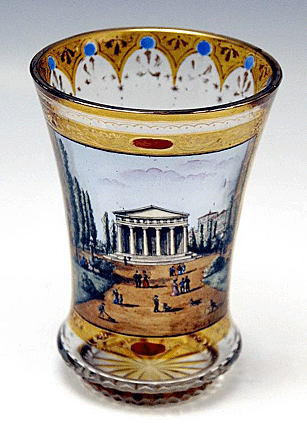 The
invention of painting in transparent enamel colors opened up the
souvenir market. Immediately it became possible to paint in far greater
detail and with more sensitivity than earlier artists using opaque
colors. From about 1810 a series of major artists began decorating glass
in wild and romantic mountain scenes, ruined castles, and gothic
fantasies which appealed to the sense of awe, while genre scenes of
children and animals satisfied the sentimental. Samuel Mohn, who settled
in Dresden in 1809, and his son Gottlieb, who worked chiefly in Vienna
achieved the highest standards of paintings. The father painted simple
naturalistic landscapes, views of cities and churches, and the son
indulged in romantic pastorals and sentimental allegories. The
invention of painting in transparent enamel colors opened up the
souvenir market. Immediately it became possible to paint in far greater
detail and with more sensitivity than earlier artists using opaque
colors. From about 1810 a series of major artists began decorating glass
in wild and romantic mountain scenes, ruined castles, and gothic
fantasies which appealed to the sense of awe, while genre scenes of
children and animals satisfied the sentimental. Samuel Mohn, who settled
in Dresden in 1809, and his son Gottlieb, who worked chiefly in Vienna
achieved the highest standards of paintings. The father painted simple
naturalistic landscapes, views of cities and churches, and the son
indulged in romantic pastorals and sentimental allegories.
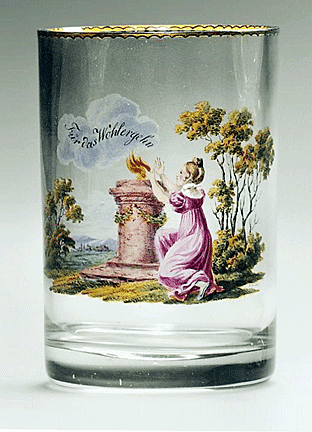 Followers
of the Mohns worked in Berlin and Bohemia as well as Vienna, and in all
the spas and watering-places—such as Carlsbad, Marienbad, Views of Baden
appear on tumblers and goblets with increasing regularity after 1815.
Anton Kothgasser of Vienna carried the fashion to its peak. His
portraits, genre scenes, moonlit views and illustrations of proverbs,
usually set in elegant gilt borders, are technically superb, works of
art. There was no lack of imitators, and the fashion remained vital
until the 1850s although the standard, especially on glasses designed
export, had begun to decline. Followers
of the Mohns worked in Berlin and Bohemia as well as Vienna, and in all
the spas and watering-places—such as Carlsbad, Marienbad, Views of Baden
appear on tumblers and goblets with increasing regularity after 1815.
Anton Kothgasser of Vienna carried the fashion to its peak. His
portraits, genre scenes, moonlit views and illustrations of proverbs,
usually set in elegant gilt borders, are technically superb, works of
art. There was no lack of imitators, and the fashion remained vital
until the 1850s although the standard, especially on glasses designed
export, had begun to decline.
Glass factories produced great quantities of engraved and cut clear
glass, mostly for the export market, throughout the 19th century. These
reflected common tastes and was usually heavy and repetitive. In Germany
and the Austro-Hungarian Empire, the tables of wealthy city-dwellers and
country farmers would have been decorated with cheap machine-made
pressed glass or clear and colored glass with crude enamel designs.
These pieces, with sprays of flowers, birds, or more modern emblems,
such as railway trains, hark back to the 17th century.
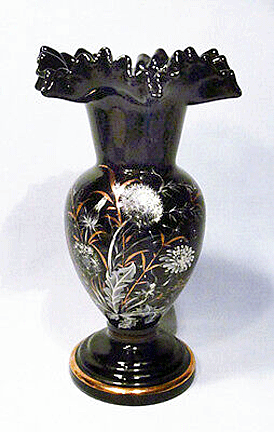 Innovation
was for the wealthy new patrons whose taste dictated the use of new
colors and materials. Bohemia's response to this demand the 1830s and
'40s was the most colorful in its long history of glassmaking. Innovation
was for the wealthy new patrons whose taste dictated the use of new
colors and materials. Bohemia's response to this demand the 1830s and
'40s was the most colorful in its long history of glassmaking.
Just as white opaque glass, called rnilchglas, had been made to
imitate porcelain, 19th-century inventors strove to match the black
basalts of Wedgwood. In 1822 Count George Buqu succeeded in creating a
dense black glass which he called hyalith, and also a red glaze
curiously like sealing wax. Enhanced with form designs of Chinoiserie
scenes in fire-gilding, Its effect on his tall vases and tea- or
coffee-sets was monumental. Later he developed what he called lithyalin,
a marbled glass of astonishing variety, like jasper or agate whose
colors ranged from brick red streaked with green to deep blue and
purples. These,, too, he gilded and painted, sometimes with simple
mottoes like `Erinnerung' (Remembrance). Bugu used Hyalith and lithyalin
for vases, beakers, table-sets, scent-bottles, inkwells and
candlesticks.
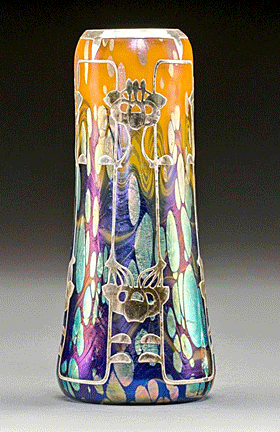 Egermann
was a notable inventor; he discovered the gold stain, made with silver,
which Kothgasser often used as a background color, and he made possible
the cheap manufacture of ruby glass, by replacing the gold with copper.
A wave of striking colors characterized the 1830s, as glasshouses added
new substances like antimony and uraniurn. Turquoise, topaz, chrysoprase,
and the shades of uranium green called Annagriin and Annagelb came from
the factory of Joseph Riedel. But new color in glass was only one of
many innovations bringing the finest glassware within range of the
middle-class market. Stained glass (clear glass given a surface color)
was Egermann
was a notable inventor; he discovered the gold stain, made with silver,
which Kothgasser often used as a background color, and he made possible
the cheap manufacture of ruby glass, by replacing the gold with copper.
A wave of striking colors characterized the 1830s, as glasshouses added
new substances like antimony and uraniurn. Turquoise, topaz, chrysoprase,
and the shades of uranium green called Annagriin and Annagelb came from
the factory of Joseph Riedel. But new color in glass was only one of
many innovations bringing the finest glassware within range of the
middle-class market. Stained glass (clear glass given a surface color)
was
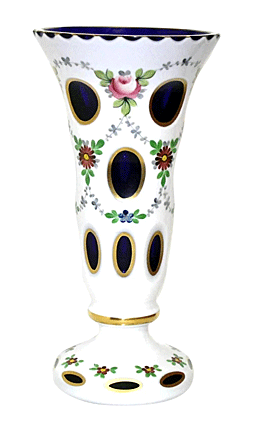 widely
popular and to the 18th-century purple stains were added to vivid reds,
greens, yellows and sometimes a layer of gold or silver arabesques in
high relief. widely
popular and to the 18th-century purple stains were added to vivid reds,
greens, yellows and sometimes a layer of gold or silver arabesques in
high relief.
The most noted technique, however, was that of overlay, or cased, glass,
in which glasshouses encased a vessel in opaque glass or glass of
another color. Workers then cut these surfaces away in broad facets to
reveal the contrasting layers beneath. The panels would be shaped and
then finely gilded, painted or engraved as the designer's fancy chose.
Until the 1850s, the process remained a secret in Bohemia.Decanters and
sets of glasses, lusters and tall vases were for sale for high prices in
London, Paris and New York until imitators caught up and repeated the
technique.
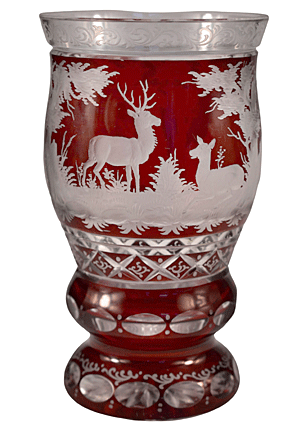 The
variety of decoration, even on the basic tumbler, was astounding.
Bohemian supremacy lasted until the 1848 Revolution shook the whole of
Europe. The
variety of decoration, even on the basic tumbler, was astounding.
Bohemian supremacy lasted until the 1848 Revolution shook the whole of
Europe.
Bohemian glassworks could hardly have fought off the competition from
Britain and America for the entire 19th century. Cutting costs was the
answer; and for every fine example of an engraved goblet or a painted
overlay tumbler, glass factories sent out a dozen factory-made lifeless
copies in the 1850s and '60s. Designs deteriorated and forms became
heavy. The restless search for novelty produced pearl satin glass and
imitations of Venetian latticinio, millefiori, and aventurine glass —yet
the results weren’t inspiring. Bohemian glassmakers sent large
quantities to America, and the firm of Lazarus and Rosenfeld of New York
distributed what they called “Bohemian art glass ware”— lamps and vases
in “Rose de Boheme” and “Green de Boheme”—cheap things from Altrohlau
and Steinschonau.
The Reworking of the Classic Vase
From the 1870s to the early 1900s, Bohemian glassworkers reworked the
classic vase form into swirling, organic-looking shapes like seashells,
flowers, and tree trunks. Decorative vases, cups, and pitchers were
popular forms, and many of the pieces have an iridescent sheen from the
firing and reduction techniques used at the time.
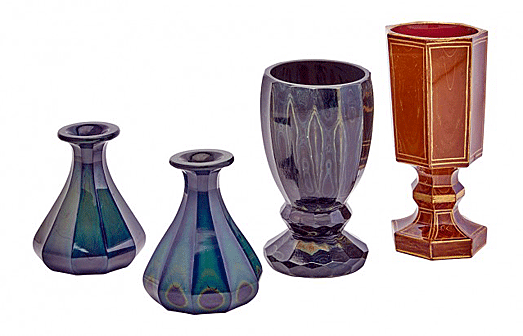
It was the Lithyalin glass of the 1850s that paved the way for the
iridescent Art Nouveau art glass. Types of "marbled" glass signaled a
shift away from a study of form to an infatuation with surface
treatments and techniques.
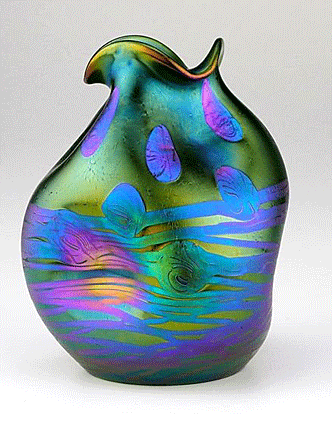 One
of the manufacturers leading the art glass movement was Loetz Glass. The
firm’s pieces included vases, pitchers, and bowls in the Phänomen
series, which it patented in 1898. The series featured rippled or
featherlike designs on the object’s surface, which glassblowers achieved
by wrapping a molten piece of glass with equally hot glass threads, then
pulling those threads to make waves and other designs while the
materials were still malleable. One
of the manufacturers leading the art glass movement was Loetz Glass. The
firm’s pieces included vases, pitchers, and bowls in the Phänomen
series, which it patented in 1898. The series featured rippled or
featherlike designs on the object’s surface, which glassblowers achieved
by wrapping a molten piece of glass with equally hot glass threads, then
pulling those threads to make waves and other designs while the
materials were still malleable.
The Kralik glassworks was another well-known maker of antique Bohemian
art glass. It produced mostly jars, vases, shells in the style of Loetz.
Another contemporary of Loetz was Rindskopf and Sons. It produced tall
vases with slender bodies and bulbous heads.
Pallme-König and Habel had its own patent for threading glass onto a
vase. Their threading ranged from tight and regular lines to treatments
that were almost Jackson Pollock-like, in which the thick threads of
glass appear to be the only things that are keeping the deformed shapes
underlying them from collapsing and falling apart.
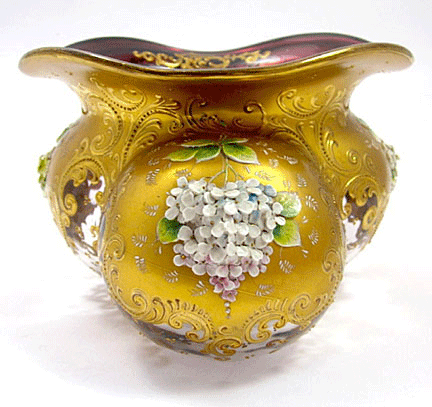 Of
all the Bohemian glassmakers of the 19th century, Ludwig Moser, known as
the “King of Glass,” is probably the most famous. His company, Ludwig
Moser & Sons of Karlsbad became known for its heavy and intricate gold
enameling on its cut, gilded, and acid-etched wares. But Moser wasn’t
the only glass decorator to adorn blanks with this type of decoration.
Glassmakers copied each other in an effort to get their share of the
market. Like many Bohemian firms, Moser sold blanks to other companies
for decoration and decorated blanks bought from other companies, such as
Loetz, Meyr's Neffe and Harrachov, so it can be difficult to tell if
Moser indeed made a particular piece. Of
all the Bohemian glassmakers of the 19th century, Ludwig Moser, known as
the “King of Glass,” is probably the most famous. His company, Ludwig
Moser & Sons of Karlsbad became known for its heavy and intricate gold
enameling on its cut, gilded, and acid-etched wares. But Moser wasn’t
the only glass decorator to adorn blanks with this type of decoration.
Glassmakers copied each other in an effort to get their share of the
market. Like many Bohemian firms, Moser sold blanks to other companies
for decoration and decorated blanks bought from other companies, such as
Loetz, Meyr's Neffe and Harrachov, so it can be difficult to tell if
Moser indeed made a particular piece.
Beautifully made pieces of Bohemian art glass dominated the interiors of
homes both in Europe and America from the last quarter of the 19th
century into the first decade or two of the 20th.
< Back
to Collectibles Archives
Next Article >
|
